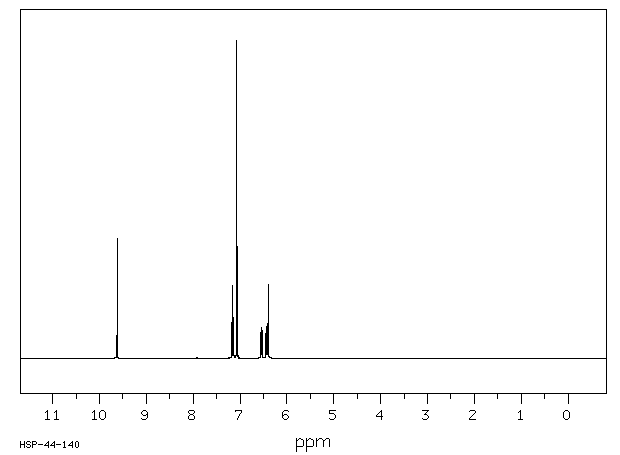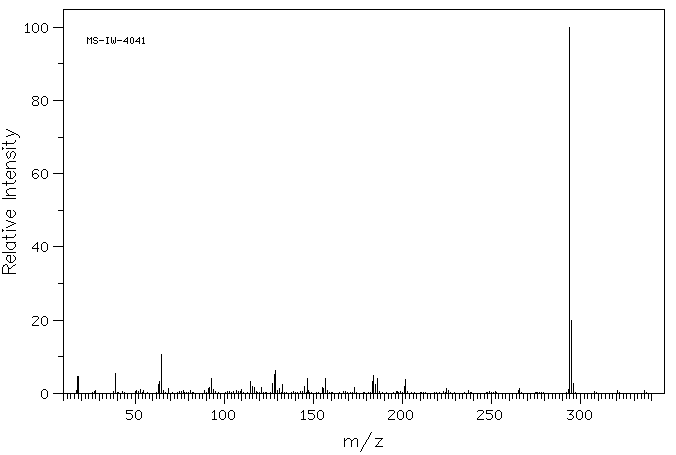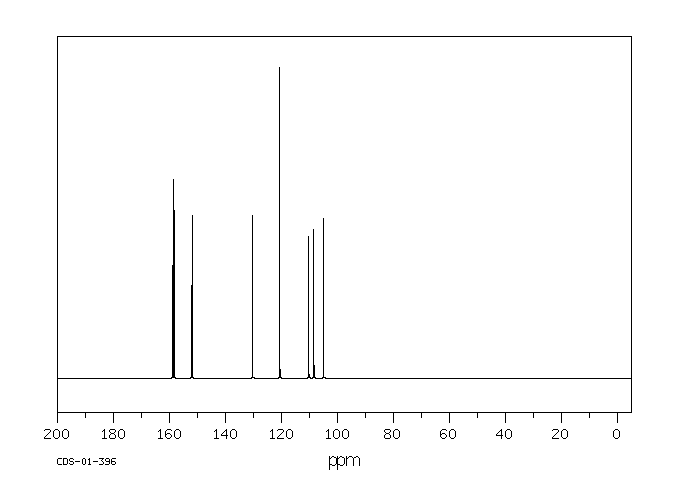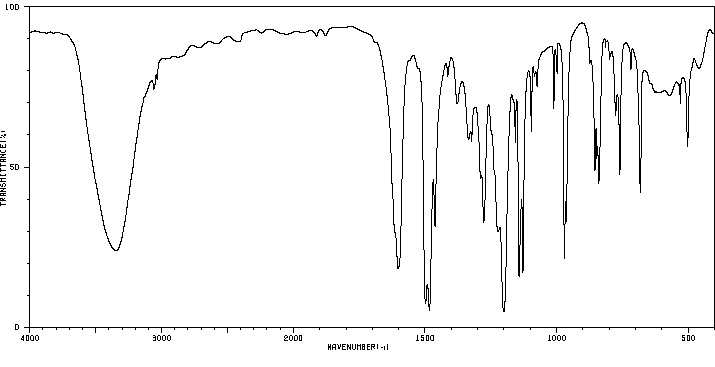1,4-二(3-羟基苯氧基)苯 | 5085-95-0
中文名称
1,4-二(3-羟基苯氧基)苯
中文别名
1,4-双(3-羟基苯氧基)苯;对苯二酚二(3-羟基苯基)醚
英文名称
1,4-bis(3-hydroxyphenoxy)benzene
英文别名
3-[4-(3-hydroxyphenoxy)phenoxy]phenol
CAS
5085-95-0
化学式
C18H14O4
mdl
——
分子量
294.307
InChiKey
CHBWEVDVYGBMEJ-UHFFFAOYSA-N
BEILSTEIN
——
EINECS
——
-
物化性质
-
计算性质
-
ADMET
-
安全信息
-
SDS
-
制备方法与用途
-
上下游信息
-
文献信息
-
表征谱图
-
同类化合物
-
相关功能分类
-
相关结构分类
物化性质
-
熔点:126 °C
-
溶解度:在甲醇中几乎透明
-
稳定性/保质期:
在常温常压下保持稳定
计算性质
-
辛醇/水分配系数(LogP):4.3
-
重原子数:22
-
可旋转键数:4
-
环数:3.0
-
sp3杂化的碳原子比例:0.0
-
拓扑面积:58.9
-
氢给体数:2
-
氢受体数:4
安全信息
-
海关编码:2909500000
-
储存条件:常温、避光、存于阴凉干燥处,并请密封保存。
SDS
1,4-双(3-羟基苯氧基)苯 修改号码:5
模块 1. 化学品
产品名称: 1,4-Bis(3-hydroxyphenoxy)benzene
修改号码: 5
模块 2. 危险性概述
GHS分类
物理性危害 未分类
健康危害 未分类
环境危害 未分类
GHS标签元素
图标或危害标志 无
信号词 无信号词
危险描述 无
防范说明 无
模块 3. 成分/组成信息
单一物质/混和物 单一物质
化学名(中文名): 1,4-双(3-羟基苯氧基)苯
百分比: >96.0%(GC)
CAS编码: 5085-95-0
俗名: Hydroquinone Bis(3-hydroxyphenyl) Ether
分子式: C18H14O4
模块 4. 急救措施
吸入: 将受害者移到新鲜空气处,保持呼吸通畅,休息。若感不适请求医/就诊。
皮肤接触: 立即去除/脱掉所有被污染的衣物。用水清洗皮肤/淋浴。
若皮肤刺激或发生皮疹:求医/就诊。
眼睛接触: 用水小心清洗几分钟。如果方便,易操作,摘除隐形眼镜。继续清洗。
如果眼睛刺激:求医/就诊。
食入: 若感不适,求医/就诊。漱口。
紧急救助者的防护: 救援者需要穿戴个人防护用品,比如橡胶手套和气密性护目镜。
模块 5. 消防措施
合适的灭火剂: 干粉,泡沫,雾状水,二氧化碳
1,4-双(3-羟基苯氧基)苯 修改号码:5
模块 5. 消防措施
特定方法: 从上风处灭火,根据周围环境选择合适的灭火方法。
非相关人员应该撤离至安全地方。
周围一旦着火:如果安全,移去可移动容器。
消防员的特殊防护用具: 灭火时,一定要穿戴个人防护用品。
模块 6. 泄漏应急处理
个人防护措施,防护用具, 使用个人防护用品。远离溢出物/泄露处并处在上风处。
紧急措施: 泄露区应该用安全带等圈起来,控制非相关人员进入。
环保措施: 防止进入下水道。
控制和清洗的方法和材料: 清扫收集粉尘,封入密闭容器。注意切勿分散。附着物或收集物应该立即根据合适的
法律法规处置。
模块 7. 操作处置与储存
处理
技术措施: 在通风良好处进行处理。穿戴合适的防护用具。防止粉尘扩散。处理后彻底清洗双手
和脸。
注意事项: 如果粉尘或浮质产生,使用局部排气。
操作处置注意事项: 避免接触皮肤、眼睛和衣物。
贮存
储存条件: 保持容器密闭。存放于凉爽、阴暗处。
远离不相容的材料比如氧化剂存放。
包装材料: 依据法律。
模块 8. 接触控制和个体防护
工程控制: 尽可能安装封闭体系或局部排风系统,操作人员切勿直接接触。同时安装淋浴器和洗
眼器。
个人防护用品
呼吸系统防护: 防尘面具。依据当地和政府法规。
手部防护: 防护手套。
眼睛防护: 安全防护镜。如果情况需要,佩戴面具。
皮肤和身体防护: 防护服。如果情况需要,穿戴防护靴。
模块 9. 理化特性
固体
外形(20°C):
外观: 晶体-粉末
颜色: 浅黄色-红黄色
气味: 无资料
pH: 无数据资料
熔点:
126°C
沸点/沸程 无资料
闪点: 无资料
爆炸特性
爆炸下限: 无资料
爆炸上限: 无资料
密度: 无资料
溶解度:
[水] 无资料
[其他溶剂] 无资料
1,4-双(3-羟基苯氧基)苯 修改号码:5
模块 10. 稳定性和反应性
化学稳定性: 一般情况下稳定。
危险反应的可能性: 未报道特殊反应性。
须避免接触的物质 氧化剂
危险的分解产物: 一氧化碳, 二氧化碳
模块 11. 毒理学信息
急性毒性: 无资料
对皮肤腐蚀或刺激: 无资料
对眼睛严重损害或刺激: 无资料
生殖细胞变异原性: 无资料
致癌性:
IARC = 无资料
NTP = 无资料
生殖毒性: 无资料
模块 12. 生态学信息
生态毒性:
鱼类: 无资料
甲壳类: 无资料
藻类: 无资料
残留性 / 降解性: 无资料
潜在生物累积 (BCF): 无资料
土壤中移动性
log水分配系数: 无资料
土壤吸收系数 (Koc): 无资料
亨利定律 无资料
constaNT(PaM3/mol):
模块 13. 废弃处置
如果可能,回收处理。请咨询当地管理部门。建议在可燃溶剂中溶解混合,在装有后燃和洗涤装置的化学焚烧炉中
焚烧。废弃处置时请遵守国家、地区和当地的所有法规。
模块 14. 运输信息
联合国分类: 与联合国分类标准不一致
UN编号: 未列明
模块 15. 法规信息
《危险化学品安全管理条例》(2002年1月26日国务院发布,2011年2月16日修订): 针对危险化学品的安全使用、
生产、储存、运输、装卸等方面均作了相应的规定。
1,4-双(3-羟基苯氧基)苯 修改号码:5
模块16 - 其他信息
N/A
模块 1. 化学品
产品名称: 1,4-Bis(3-hydroxyphenoxy)benzene
修改号码: 5
模块 2. 危险性概述
GHS分类
物理性危害 未分类
健康危害 未分类
环境危害 未分类
GHS标签元素
图标或危害标志 无
信号词 无信号词
危险描述 无
防范说明 无
模块 3. 成分/组成信息
单一物质/混和物 单一物质
化学名(中文名): 1,4-双(3-羟基苯氧基)苯
百分比: >96.0%(GC)
CAS编码: 5085-95-0
俗名: Hydroquinone Bis(3-hydroxyphenyl) Ether
分子式: C18H14O4
模块 4. 急救措施
吸入: 将受害者移到新鲜空气处,保持呼吸通畅,休息。若感不适请求医/就诊。
皮肤接触: 立即去除/脱掉所有被污染的衣物。用水清洗皮肤/淋浴。
若皮肤刺激或发生皮疹:求医/就诊。
眼睛接触: 用水小心清洗几分钟。如果方便,易操作,摘除隐形眼镜。继续清洗。
如果眼睛刺激:求医/就诊。
食入: 若感不适,求医/就诊。漱口。
紧急救助者的防护: 救援者需要穿戴个人防护用品,比如橡胶手套和气密性护目镜。
模块 5. 消防措施
合适的灭火剂: 干粉,泡沫,雾状水,二氧化碳
1,4-双(3-羟基苯氧基)苯 修改号码:5
模块 5. 消防措施
特定方法: 从上风处灭火,根据周围环境选择合适的灭火方法。
非相关人员应该撤离至安全地方。
周围一旦着火:如果安全,移去可移动容器。
消防员的特殊防护用具: 灭火时,一定要穿戴个人防护用品。
模块 6. 泄漏应急处理
个人防护措施,防护用具, 使用个人防护用品。远离溢出物/泄露处并处在上风处。
紧急措施: 泄露区应该用安全带等圈起来,控制非相关人员进入。
环保措施: 防止进入下水道。
控制和清洗的方法和材料: 清扫收集粉尘,封入密闭容器。注意切勿分散。附着物或收集物应该立即根据合适的
法律法规处置。
模块 7. 操作处置与储存
处理
技术措施: 在通风良好处进行处理。穿戴合适的防护用具。防止粉尘扩散。处理后彻底清洗双手
和脸。
注意事项: 如果粉尘或浮质产生,使用局部排气。
操作处置注意事项: 避免接触皮肤、眼睛和衣物。
贮存
储存条件: 保持容器密闭。存放于凉爽、阴暗处。
远离不相容的材料比如氧化剂存放。
包装材料: 依据法律。
模块 8. 接触控制和个体防护
工程控制: 尽可能安装封闭体系或局部排风系统,操作人员切勿直接接触。同时安装淋浴器和洗
眼器。
个人防护用品
呼吸系统防护: 防尘面具。依据当地和政府法规。
手部防护: 防护手套。
眼睛防护: 安全防护镜。如果情况需要,佩戴面具。
皮肤和身体防护: 防护服。如果情况需要,穿戴防护靴。
模块 9. 理化特性
固体
外形(20°C):
外观: 晶体-粉末
颜色: 浅黄色-红黄色
气味: 无资料
pH: 无数据资料
熔点:
126°C
沸点/沸程 无资料
闪点: 无资料
爆炸特性
爆炸下限: 无资料
爆炸上限: 无资料
密度: 无资料
溶解度:
[水] 无资料
[其他溶剂] 无资料
1,4-双(3-羟基苯氧基)苯 修改号码:5
模块 10. 稳定性和反应性
化学稳定性: 一般情况下稳定。
危险反应的可能性: 未报道特殊反应性。
须避免接触的物质 氧化剂
危险的分解产物: 一氧化碳, 二氧化碳
模块 11. 毒理学信息
急性毒性: 无资料
对皮肤腐蚀或刺激: 无资料
对眼睛严重损害或刺激: 无资料
生殖细胞变异原性: 无资料
致癌性:
IARC = 无资料
NTP = 无资料
生殖毒性: 无资料
模块 12. 生态学信息
生态毒性:
鱼类: 无资料
甲壳类: 无资料
藻类: 无资料
残留性 / 降解性: 无资料
潜在生物累积 (BCF): 无资料
土壤中移动性
log水分配系数: 无资料
土壤吸收系数 (Koc): 无资料
亨利定律 无资料
constaNT(PaM3/mol):
模块 13. 废弃处置
如果可能,回收处理。请咨询当地管理部门。建议在可燃溶剂中溶解混合,在装有后燃和洗涤装置的化学焚烧炉中
焚烧。废弃处置时请遵守国家、地区和当地的所有法规。
模块 14. 运输信息
联合国分类: 与联合国分类标准不一致
UN编号: 未列明
模块 15. 法规信息
《危险化学品安全管理条例》(2002年1月26日国务院发布,2011年2月16日修订): 针对危险化学品的安全使用、
生产、储存、运输、装卸等方面均作了相应的规定。
1,4-双(3-羟基苯氧基)苯 修改号码:5
模块16 - 其他信息
N/A
上下游信息
-
下游产品
中文名称 英文名称 CAS号 化学式 分子量 —— 2,8,14,20-Tetraoxapentacyclo[19.2.2.13,7.19,13.115,19]octacosa-1(23),3(28),4,6,9(27),10,12,15,17,19(26),21,24-dodecaene 1550054-25-5 C24H16O4 368.389
反应信息
-
作为反应物:描述:1,4-二(3-羟基苯氧基)苯 在 sodium carbonate 、 一水合肼 、 钯 作用下, 以 四氢呋喃 、 N,N-二甲基甲酰胺 为溶剂, 反应 6.0h, 生成 1,4-bis[3-(6-amino-3-pyridazinyloxy)]benzene参考文献:名称:含哒嗪基团的二胺单体及其制备方法与应用摘要:本发明的含哒嗪基团的二胺单体及其制备方法与应用属于有机合成技术领域。本发明提供了一种含哒嗪结构的二胺单体及其制备方法与应用,采用亲核取代法将含有柔性基团或不对称结构或大体积侧基的二羟基化合物与含氯硝基哒嗪反应制备得到含有哒嗪结构的二硝基中间体,将含有哒嗪结构的二硝基产物中间体还原后得到含有哒嗪结构的二胺单体;将含有哒嗪结构的二胺单体与二酐反应,热亚胺化后,得到高性能杂环聚酰亚胺薄膜。本发明的高性能杂环聚酰亚胺薄膜不仅保持原有聚酰亚胺优异的热性能和机械性能,在溶解性和光透过性方面有显著提高,具有广阔的应用前景。公开号:CN107056711B
-
作为产物:描述:2-bromo-3-{4-[(2-bromo-3-oxocyclohex-1-en-1-yl)oxy]phenoxy}cyclohex-2-ene-1-one 在 1,8-二氮杂双环[5.4.0]十一碳-7-烯 作用下, 以 甲苯 为溶剂, 以31 %的产率得到1,4-二(3-羟基苯氧基)苯参考文献:名称:用于制备 3-芳氧基苯酚的经典 Ullmann 偶联的温和替代方法摘要:m eta -(Aryloxy)phenols 由 DBU 与 2-bromo-3-(aryloxy)cyclohex-2-en-1-ones 作用形成,后者很容易从 3-chlorocyclohex-2-en-1-ones 中获得两个步骤:用芳氧基取代氯(ArOH、K 2 CO 3、在 100 °C 下回流丙酮或 DMF)和溴化(NBS、DMF、室温)。该过程提供了一种温和的替代经典乌尔曼反应的方法,不需要任何金属催化剂。如果原始苯酚 (ArOH) 带有供电子基团,则该方法效果很好,但当取代基吸电子时,芳构化步骤 (DBU) 会伴随 ArO 单元的一些损失。DOI:10.1016/j.tet.2023.133264
文献信息
-
Copper/iron-catalyzed Ullmann coupling of diiodo- and dibromoarenes and diphenols for the synthesis of aryl ether macrocycles作者:Qizhong Zhou、Liangjun Su、Tiansheng Jiang、Bin Zhang、Rener Chen、Huajiang Jiang、Yuyuan Ye、Mengqing Zhu、Deman Han、Jianfen Shen、Guoliang Dai、Zhanting LiDOI:10.1016/j.tet.2013.12.089日期:2014.2dibromoarenes) reacted with diphenols, catalyzed by CuI/Fe(acac)3 in the presence of K2CO3 in anhydrous DMSO at 110 °C for 7 days under nitrogen atmosphere, to afford macrocyclic aryl ethers effectively. To expand this methodology, a cyclic hepta(p-phenylene oxide) and cyclic deca(p-phenylene oxide) were synthesized in one pot. Some macrocyclic aryl ethers showed strong fluorescence in acetone at 25 °C.
-
Compositions for producing polymers of high refractive index and low yellowness申请人:PPG INDUSTRIES, INC.公开号:EP0224123A2公开(公告)日:1987-06-03The yellowness of polymerizates formed from polymerizable compositions containing bisphenol bis(allylic carbonate)-functional material is reduced by inclusion of one or more cyclohexenic compounds in the polymerizable compositions.
-
Polycarbonate resin composition申请人:Mitsubishi Engineering-Plastics Corporation公开号:US11198785B2公开(公告)日:2021-12-14A polycarbonate resin composition which has high rigidity, excellent dimensional stability, and low linear expansion properties. The polycarbonate resin composition contains, relative to 100 parts by mass of a polycarbonate resin (A), 10 to 100 parts by mass of an acrylonitrile-styrenic copolymer (B), 10 to 100 parts by mass of glass flakes (C) having an average thickness of 0.45 to 1 μm, and 5 to 50 parts by mass of glass fibers (D) having an elliptical cross section with an ellipticity of more than 1.5 and not more than 8, wherein the mass ratio (D)/(C) of the content of the glass fibers (D) having an elliptical cross section to the content of the glass flakes (C) is 0.1 to 1.
-
POLYCARBONATE RESIN COMPOSITION申请人:Mitsubishi Engineering-Plastics Corporation公开号:EP2840117B1公开(公告)日:2019-11-13
-
COPOLYMER, POLYMER ELECTROLYTE, AND USE THEREOF申请人:Masui Kentaro公开号:US20100167165A1公开(公告)日:2010-07-01The present invention is a copolymer obtained by condensation, a condensation reaction of a leaving group and a nucleophilic group, of a mixture of the following (A) and (C) with a mixture of (B) and (D), or of a mixture of (A), (B), (C) and (D): (A) a monomer having two leaving groups and further at least one acid group in a molecule; (B) a monomer having two nucleophilic groups and further at least one acid group in a molecule; (C) a monomer having two leaving groups and substantially no acid group in a molecule; and (D) a monomer having two nucleophilic groups and substantially no acid group in a molecule.
表征谱图
-
氢谱1HNMR
-
质谱MS
-
碳谱13CNMR
-
红外IR
-
拉曼Raman
-
峰位数据
-
峰位匹配
-
表征信息
同类化合物
(βS)-β-氨基-4-(4-羟基苯氧基)-3,5-二碘苯甲丙醇
(S,S)-邻甲苯基-DIPAMP
(S)-(-)-7'-〔4(S)-(苄基)恶唑-2-基]-7-二(3,5-二-叔丁基苯基)膦基-2,2',3,3'-四氢-1,1-螺二氢茚
(S)-盐酸沙丁胺醇
(S)-3-(叔丁基)-4-(2,6-二甲氧基苯基)-2,3-二氢苯并[d][1,3]氧磷杂环戊二烯
(S)-2,2'-双[双(3,5-三氟甲基苯基)膦基]-4,4',6,6'-四甲氧基联苯
(S)-1-[3,5-双(三氟甲基)苯基]-3-[1-(二甲基氨基)-3-甲基丁烷-2-基]硫脲
(R)富马酸托特罗定
(R)-(-)-盐酸尼古地平
(R)-(-)-4,12-双(二苯基膦基)[2.2]对环芳烷(1,5环辛二烯)铑(I)四氟硼酸盐
(R)-(+)-7-双(3,5-二叔丁基苯基)膦基7''-[((6-甲基吡啶-2-基甲基)氨基]-2,2'',3,3''-四氢-1,1''-螺双茚满
(R)-(+)-7-双(3,5-二叔丁基苯基)膦基7''-[(4-叔丁基吡啶-2-基甲基)氨基]-2,2'',3,3''-四氢-1,1''-螺双茚满
(R)-(+)-7-双(3,5-二叔丁基苯基)膦基7''-[(3-甲基吡啶-2-基甲基)氨基]-2,2'',3,3''-四氢-1,1''-螺双茚满
(R)-(+)-4,7-双(3,5-二-叔丁基苯基)膦基-7“-[(吡啶-2-基甲基)氨基]-2,2”,3,3'-四氢1,1'-螺二茚满
(R)-3-(叔丁基)-4-(2,6-二苯氧基苯基)-2,3-二氢苯并[d][1,3]氧杂磷杂环戊烯
(R)-2-[((二苯基膦基)甲基]吡咯烷
(R)-1-[3,5-双(三氟甲基)苯基]-3-[1-(二甲基氨基)-3-甲基丁烷-2-基]硫脲
(N-(4-甲氧基苯基)-N-甲基-3-(1-哌啶基)丙-2-烯酰胺)
(5-溴-2-羟基苯基)-4-氯苯甲酮
(5-溴-2-氯苯基)(4-羟基苯基)甲酮
(5-氧代-3-苯基-2,5-二氢-1,2,3,4-oxatriazol-3-鎓)
(4S,5R)-4-甲基-5-苯基-1,2,3-氧代噻唑烷-2,2-二氧化物-3-羧酸叔丁酯
(4S,4''S)-2,2''-亚环戊基双[4,5-二氢-4-(苯甲基)恶唑]
(4-溴苯基)-[2-氟-4-[6-[甲基(丙-2-烯基)氨基]己氧基]苯基]甲酮
(4-丁氧基苯甲基)三苯基溴化磷
(3aR,8aR)-(-)-4,4,8,8-四(3,5-二甲基苯基)四氢-2,2-二甲基-6-苯基-1,3-二氧戊环[4,5-e]二恶唑磷
(3aR,6aS)-5-氧代六氢环戊基[c]吡咯-2(1H)-羧酸酯
(2Z)-3-[[(4-氯苯基)氨基]-2-氰基丙烯酸乙酯
(2S,3S,5S)-5-(叔丁氧基甲酰氨基)-2-(N-5-噻唑基-甲氧羰基)氨基-1,6-二苯基-3-羟基己烷
(2S,2''S,3S,3''S)-3,3''-二叔丁基-4,4''-双(2,6-二甲氧基苯基)-2,2'',3,3''-四氢-2,2''-联苯并[d][1,3]氧杂磷杂戊环
(2S)-(-)-2-{[[[[3,5-双(氟代甲基)苯基]氨基]硫代甲基]氨基}-N-(二苯基甲基)-N,3,3-三甲基丁酰胺
(2S)-2-[[[[[((1S,2S)-2-氨基环己基]氨基]硫代甲基]氨基]-N-(二苯甲基)-N,3,3-三甲基丁酰胺
(2S)-2-[[[[[[((1R,2R)-2-氨基环己基]氨基]硫代甲基]氨基]-N-(二苯甲基)-N,3,3-三甲基丁酰胺
(2-硝基苯基)磷酸三酰胺
(2,6-二氯苯基)乙酰氯
(2,3-二甲氧基-5-甲基苯基)硼酸
(1S,2S,3S,5S)-5-叠氮基-3-(苯基甲氧基)-2-[(苯基甲氧基)甲基]环戊醇
(1S,2S,3R,5R)-2-(苄氧基)甲基-6-氧杂双环[3.1.0]己-3-醇
(1-(4-氟苯基)环丙基)甲胺盐酸盐
(1-(3-溴苯基)环丁基)甲胺盐酸盐
(1-(2-氯苯基)环丁基)甲胺盐酸盐
(1-(2-氟苯基)环丙基)甲胺盐酸盐
(1-(2,6-二氟苯基)环丙基)甲胺盐酸盐
(-)-去甲基西布曲明
龙蒿油
龙胆酸钠
龙胆酸叔丁酯
龙胆酸
龙胆紫-d6
龙胆紫










